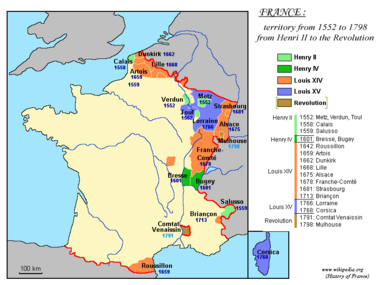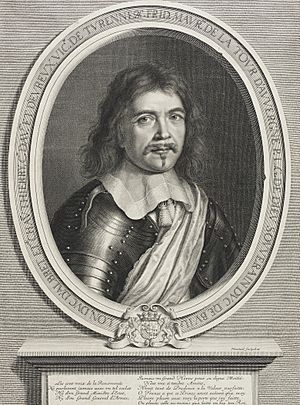Battle of La Marfée facts for kids
Quick facts for kids Battle of La Marfée |
|||||||
|---|---|---|---|---|---|---|---|
| Part of Franco-Spanish War (1635–59) | |||||||
 French rebel leader Louis de Bourbon, Count of Soissons |
|||||||
|
|||||||
| Belligerents | |||||||
| Commanders and leaders | |||||||
| Strength | |||||||
| 6,000 infantry, 1,400 cavalry | 7,000 infantry, 2,500 cavalry | ||||||
| Casualties and losses | |||||||
| 200–300 killed or wounded 4,000 captured |
Nominal | ||||||
The Battle of La Marfée, also called the Battle of Sedan, happened on July 6, 1641. It was part of the Franco-Spanish War, which was connected to the bigger Thirty Years War.
This battle took place near Sedan, France. A French army, led by the Duke of Châtillon, fought against an army from the Holy Roman Empire and Spain. This Imperial-Spanish army was commanded by Guillaume de Lamboy. They were also joined by French rebels. These rebels were led by the Comte de Soissons and Frédéric Maurice de La Tour d'Auvergne, Duke of Bouillon.
The French army lost badly. However, Soissons died right at the end of the battle. It is said he was killed by his own loaded pistol while trying to open his helmet. His death changed everything for the rebels.
Contents
The Battle of La Marfée
Why the Battle Happened
France and the Habsburgs
In the 1600s, Europe was a battleground. The powerful Bourbon kings of France were constantly fighting their rivals. These rivals were the Habsburg rulers of Spain and the Holy Roman Empire.
The Habsburgs owned lands all around France. These included the Spanish Netherlands, Franche-Comté, Alsace, Roussillon, and Lorraine. France tried to weaken the Habsburgs. They supported groups fighting against them. This included rebels in the Thirty Years War and the Dutch Revolt. They also helped revolts in Portugal, Catalonia, and Naples.
Plots Against the King
Spain and Austria also tried to cause trouble for France. They helped French Protestants, called Huguenots, rebel. They also supported secret plans against the French government. These plots were often led by powerful lords. These lords were unhappy about losing their influence.
One of the main leaders of these plots was Cardinal Richelieu. He was the chief minister to the French king. In 1641, Spain's chief minister, Olivares, focused on two French nobles. These were the Comte de Soissons and Henri II de Guise. They were known as the 'Princes of Peace'. They claimed Richelieu was keeping the war going on purpose.
Since 1637, Soissons and Guise had been living in the Principality of Sedan. This area was part of the Holy Roman Empire. It was ruled by the duc de Bouillon. Bouillon was a Protestant who later became a French general.
Richelieu knew about the plot in advance. In April 1641, he told Châtillon to attack Sedan. Châtillon felt his army was too small. Soissons asked for help from the Spanish. The Spanish governor of the Netherlands sent money and 7,000 soldiers. These soldiers were led by Lamboy.
How the Battle Unfolded
On June 25, the French army took positions near Sedan. But cannons from the town forced them to move. Châtillon moved his troops further along the Meuse river. Lamboy's troops were on the other side. Châtillon waited for more soldiers, but they never came.
Soissons and Bouillon left Sedan on July 5. They had 3,000 French volunteers and mercenaries. They took positions near the village of La Marfée. Lamboy's soldiers joined them there. The Spanish soldiers hid in a nearby wood. Bouillon's cavalry (horse soldiers) were on flat ground. Soissons kept his reserve troops ready.
The morning of July 6 was very rainy. This delayed the French attack until after 10:00 AM. They formed two groups and reached La Marfée an hour later. Châtillon found his cannons were at the back. So, he sent his foot soldiers into the woods without waiting.
The Spanish soldiers first gave ground. But then the French ran into close-range cannon fire. They had to fall back. As they did, Bouillon's cavalry attacked the French right side. Their commander was killed. His troops panicked and rode over their own foot soldiers. The French left side held its ground and retreated in order. But the battle was over in less than 45 minutes. The French lost 4,000 prisoners. They also lost their cannons and supplies.
What Happened After the Battle
The End of the Conspiracy
Châtillon and some officers escaped to Rethel. There, they gathered the remaining soldiers. Charles of Lorraine then joined Lamboy. Lamboy stopped to capture Donchery, north of Sedan. This delay allowed Châtillon's remaining army to reach Reims. There, they met King Louis XIII and more soldiers.
Soissons died at the end of the battle. It seems a loaded pistol he was using to lift his helmet visor went off. His death ended the plot against the king. The Battle of La Marfée stopped Châtillon's army from helping the French attack in Flanders.
Changes in French Leadership
Plots against Richelieu continued until he died in December 1642. The most serious plot was called 'Cinq Mars' in June 1642. Many people involved with Soissons were part of it. This included Gaston of Orléans and the Marquis de Cinq-Mars. Cinq-Mars was executed.
Soon after, King Louis XIII died in May 1643. His five-year-old son, Louis XIV, became king. A group of people ruled for him. This led to a power struggle. The Queen Mother and Cardinal Mazarin were on one side. Condé, a royal family member, was on the other. Condé was a war hero.
Bouillon's Later Life
From 1648 to 1653, there was a civil war in France called the Fronde. When Condé was arrested during this time, Bouillon and Turenne worked together. They demanded his release. Both of them switched sides in 1650. Bouillon gave up Sedan and Raucourt. In return, he received other important lands. He died in Pontoise on August 9, 1652.
Images for kids
Sources
See also
 In Spanish: Batalla de La Marfée para niños
In Spanish: Batalla de La Marfée para niños




